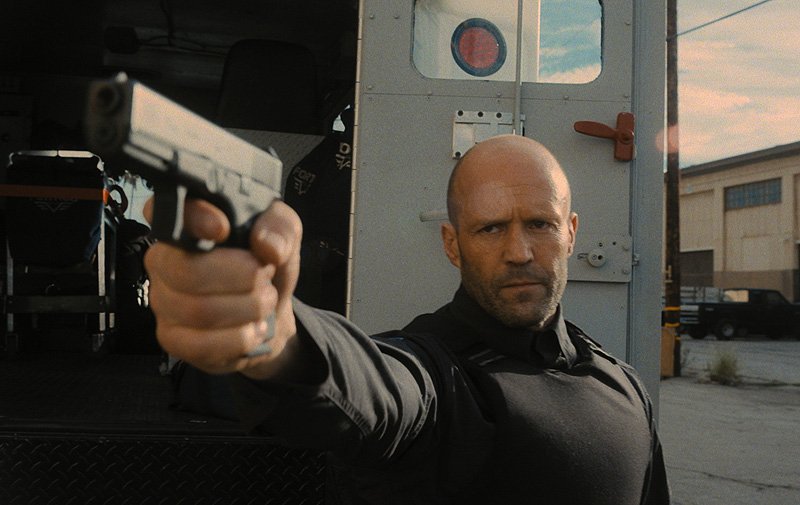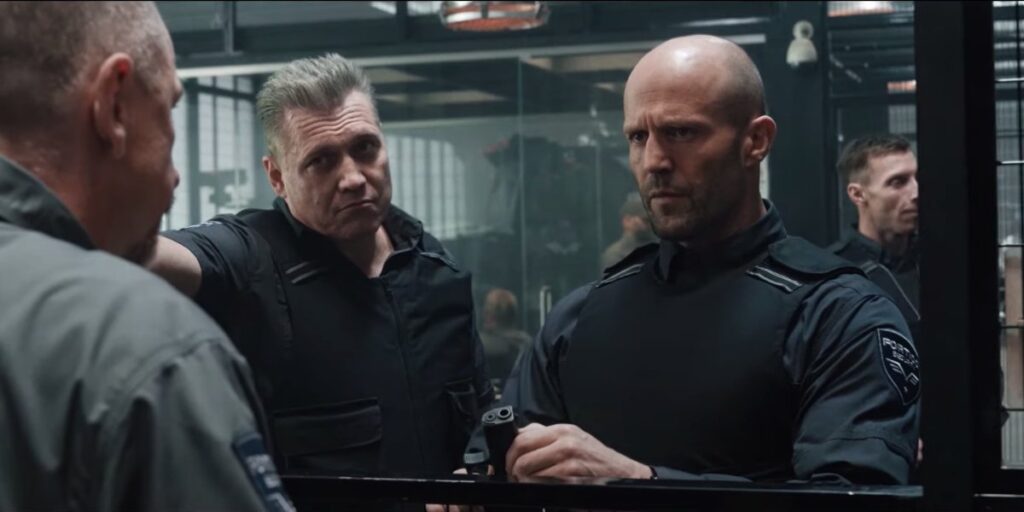
Guy Ritchie and Jason Statham: match made in tough-guy heaven, or secretly awkward fit? Historically, it’s hard to argue with the results; Statham received his first two roles in Ritchie’s first two films—the frenetic crime caper Lock, Stock, and Two Smoking Barrels, and the even more frenzied crime caper Snatch—which launched the bald Brit to stardom while also granting their director a measure of name recognition. But while both artists have since enjoyed successful careers (Statham more so than Ritchie), they thrive in different modes. Statham is a natural glowerer; his strength as an action hero stems less from his athleticism than his single-minded tenacity. But Ritchie, for all his pretensions of alpha-male seriousness, works best when deploying a light touch; The Man from U.N.C.L.E. was charming precisely because it felt frivolous rather than strenuous. If their pairing isn’t oil and water, it’s something like fists and finesse.
Wrath of Man is Ritchie and Statham’s first movie together following a 14-year separation (their third collaboration was 2007’s ill-regarded Revolver), and it takes all of 20 seconds before it declares its governing tone. As Christopher Benstead’s doomy score thunders with Zimmer-like braaams, the camera slowly pushes in on a smoggy Los Angeles, eventually locating an armored car snaking its way out of a gated facility. Within moments, the boxy car is being held up, though we never see the perpetrators; instead, the camera remains inside the vehicle, watching sparks fly as a sinister device carves its way through the side door’s thick steel. You don’t see much of what happens next, but you hear all of it—the blasts of explosives, the screams of the guards, the rip-rip-rip of gunfire—and the intensity is palpable. Most of Ritchie’s films, even the ones that traffic in extreme violence and moral depravity, are coated with a sheen of playfulness. This one wants to hurt you.
It never does, but it certainly holds your attention, at least until its dreary final act. Ritchie’s signature tics—cocky banter, colorfully brutal thugs, narratives that swoop and swirl into figure eights—are imitative by nature, and Wrath of Man can often play like pastiche; simply selecting an armored car heist for an opening sequence instantly evokes Heat, while the Tarantino touchstones remain in place, such as the gang of thieves who only refer to one another by number (except for their leader, who’s code-named Elvis). Yet for all his secondhand theatrics, Ritchie here evinces a muscular showmanship that feels reasonably distinctive.

It’s also somewhat out of character for him. Ritchie’s last movie, The Gentlemen, was a delirious and nonsensical romp through the London underworld; its perfunctory action and byzantine plotting were salvaged by some juicy dialogue and wonderfully flamboyant performances, most notably from Hugh Grant. Wrath of Man essentially operates in reverse. It’s largely humorless, and its characters are leaden and monotone, yammering in a faux-jocular repartee that feels like a studied approximation of locker-room joshing. But its many scenes of attempted robberies and carjackings are fleet, suspenseful, and efficient. The movements of the camera (operated by Alan Stewart) are purposeful and precise, and there are enough canny details—in one sequence, burglars spray black paint on a windshield to prevent the occupants from peeking out; in another, a vehicle’s weight and shape prove as important as its speed—to differentiate the smash-and-grab proceedings from the typical heist hijinks.
The plot of Wrath of Man is very complicated, which isn’t the same thing as being intricate. As is customary with these sorts of movies, it begins not at the beginning but in the middle, with Patrick Hill (Statham), nicknamed H, applying for a security position with Fortico, an armored car company. In one of the film’s early surprises, he barely passes his driving and shooting test, suggesting that he might not be suited for the job. H being played by Jason Statham, we know better.
As its title suggests, Wrath of Man is a man’s movie, with all of the testosterone and toxicity that this implies. Fortico’s workplace culture is one of persistent one-upmanship and preening masculinity. H’s colleagues, who include the wily veteran Bullet (Holt McCallany) and the arrogant Boy Sweat Dave (Josh Hartnett), casually fling cocksure boasts and homophobic insults, challenging H to pass through a crucible of manhood. (As a counterpoint, Eddie Marsan plays an effete manager, while Rob Delaney pops up for a few scenes as an oblivious suit.) Their lone female coworker, Dana (Niamh Algar), has a unisex name and isn’t afraid to get rough-and-tumble with the boys; when she eyeballs H like a lioness stalking her next meal, Bullet softly admonishes her, “Put him down.” Forget your DEI workshops and sensitivity trainings; this is a domain of chest-puffing and dick-measuring.

And H clearly has the biggest D. In a sharply staged early sequence, he single-handedly foils an attempted robbery with nothing more than his pistol and his unflappable cool, while the constrained Bullet and the paralyzed Dave look on in astonishment. Not long after, he scares off another batch of potential looters simply by revealing his face. It’s as though he’s a gangland version of The Most Interesting Man in the World.
If only Statham were worthy of the title. The lean-and-mean actor is a charismatic presence, sure, but his brand of brooding lethality is starting to grow tiresome. His work in Wrath of Man reminded me of his hilariously self-deprecating turn in Spy, in which he gamely parodied the absurdities of his on-screen persona (“I’ve jumped from a high-rise building using only a raincoat as a parachute”); H often feels like a literal incarnation of that character, drained of any winking self-awareness. His invincibility makes him a boring action hero, while his relentless dourness makes him poor company. It’s a disappointingly flat performance, one which lacks the coiled physicality that Keanu Reeves brings to the John Wick films.
Fortunately, H isn’t the only extremely proficient killing machine in town. One of the pleasures of Wrath of Man lies in the way it loops in time around its inciting incident, replaying the same robbery from different perspectives. It’s a familiar but durable gimmick, and it adds further kick to scenes that are already seething with tension. (Less impressive is the flashback montage that reveals H discreetly performing reconnaissance.) It also helps distract from the dullness of the characters. We meet various criminal and crime-adjacent types who possess uncertain motives and dubious morals; a few are businesslike gangsters with a penchant for slipping plastic bags over victims’ heads (the ferocity of the film’s violence sometimes recalls Killing Them Softly), while a smartly dressed bureaucrat commands instant respect because he’s played by Andy Garcia. Eventually, the movie alights on a cadre of ex-military operatives who struggle to slake their thirst for combat, and who manage to be ethnically diverse but still kinda racist. (When one laments that he misses killing Arabs, a compatriot gently corrects him, “Afghans aren’t Arabs.”) They’re otherwise indistinguishable, except for the truly sadistic one, who’s conspicuous because he’s played by Scott Eastwood.

What’s notable about these machine-gun-toting hooligans, aside from their intimidating hardware—seriously, I know you can buy a handgun at any drugstore in America, but where on earth do these guys shop?—is their sense of professionalism. They turn to robbery out of craft as much as greed, as they appear less concerned with stealing money than with successfully executing a difficult mission. They’re methodical in their preparation and candid about the possibility of failure; when planning an especially ambitious heist (one last job!), their leader, Jackson (Fargo’s Jeffrey Donovan), assesses their odds of death with the frankness of a meteorologist forecasting a potential rainstorm.
It’s these guys, then, who are the true Ritchie surrogates here, not Statham’s invulnerable marksman. Wrath of Man, with its intersecting plotlines and knotty screenplay (co-written by Ritchie, Marn Davies, and Ivan Atkinson, and complete with ominous chapter titles like “a dark spirit” and “scorched earth”, another arbitrary nod to Tarantino), functions primarily as a formal exercise—a challenge that Ritchie has assigned himself to measure his filmmaking gifts against those of his beloved superiors. By the time the movie arrives at its lengthy climax, it’s clear that he’s lost the battle; the repetitive exchanges of noisy gunfire are visually tedious, while Ritchie’s decision to helmet his combatants only underlines their virtual anonymity. At the same time, the sequence is cleverly edited, constantly flashing back to Jackson’s crew as they chart out contingencies and pantomime exit strategies, with toy cars to boot. That’s the rub: Ritchie’s bruising skill and periodic flair provide a robust and kinetic viewing experience, even if it centers on the least interesting men in the world.
Grade: B-
Jeremy Beck is the editor-in-chief of MovieManifesto. He watches more movies and television than he probably should.
